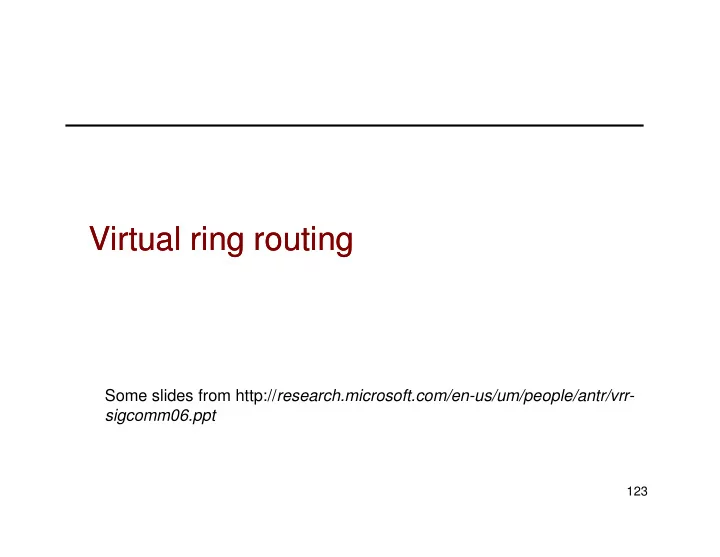

Virtual ring routing Virtual ring routing Some slides from http:// research.microsoft.com/en-us/um/people/antr/vrr- sigcomm06.ppt 123
VRR: the virtual ring VRR: the virtual ring topology-independent 0 FFF node identifiers, e.g., MAC address 910 90E 90E 8F6 8F0 8E2 each node maintains a virtual neighbor set (vset) nodes organized into virtual ring by increasing identifier value 124
VRR: routing paths VRR: routing paths 8F6 8F6 physical network topology nodes only maintain paths to virtual neighbors: • vset-paths are typically multi-hop • vset-paths are maintained proactively 125
14A VRR: forwarding table VRR: forwarding table F42 endpointA endpointB nextA nextB pathId 31 8F6 90E ME F42 910 8F6 10E ME 10 8F6 14A 140 F42 10E 2 F42 ME 8F6 F42 FF 10E forwarding table for node 8F6 • vset-paths recorded in forwarding tables along path • forwarding table contains 140 • vset-paths between node and vset members • vset-paths between other nodes that go through node • paths to physical neighbors 126
VRR: forwarding VRR: forwarding • forward message destined to x by – picking endpoint e numerically closest to x – forwarding message to next hop towards e • deliver message to node with id closest to x • deliver message to node with id closest to x • how does this work ? – can find x because nodes are connected in a ring – low stretch because of additional forwarding state – many alternate paths to route around failures 127
VRR: example routing VRR: example routing physical network Topology 128
VRR: example routing VRR: example routing there may be some stretch physical network Topology 129
Node joining Node joining broadcast hellos to find physical neighbors send setup request to 16E send setup request to 16E (itself) through proxy (19A) 164 8F6 19A Network Topology 16E 130
Node joining Node joining 16E sends setup requests to nodes in received vset 164 sends setup to 16E with its vset 16E adds node to vset 16E adds node to vset when it receives setup 164 171 8F6 19A Network Topology 16E 131
Size of routing table Size of routing table • Assume the nodes are randomly placed, each vpath 132
Simulation experiments in ns Simulation experiments in ns-2 2 • ran experiments with 802.11b MAC • varied network size, mobility, session lifetime • compared with DSDV, DSR, and AODV • VRR performed well in all experiments – high delivery ratios even with fast movement – significantly lower delays with route instability 133
Delivery ratio: fast movement Delivery ratio: fast movement 100 90 80 70 ratio 60 60 Delivery ra DSDV 50 DSR AODV 40 VRR 30 20 10 0 0 50 100 150 200 134 Number of nodes
Delay: fast movement Delay: fast movement 14 12 10 econds) DSDV 8 DSR Delay (sec AODV 6 VRR 4 2 0 0 50 100 150 200 135 Number of nodes
Sensor network Sensor network • sensor network testbed – 67 mica2dot motes in UCB building • comparison with BVR • delivery ratio with mote failures • delivery ratio with mote failures 136
Sensor network: mote failures Sensor network: mote failures 130 100 ackets delivered 98 120 96 of nodes 110 94 100 92 Number of Percentage of pa 90 90 Number of nodes VRR delivery ratio 88 80 BVR delivery ratio 86 70 84 60 82 50 80 0 1 2 3 4 5 6 7 8 9 101112131415 Time (mins) 137
Wireless office testbed Wireless office testbed • 30 machines running windows • communicate using 802.11a • throughput comparison with LQSR using ttcp 138
Wireless office testbed: throughput Wireless office testbed: throughput 12 MR-LQSR h (Mbps) 10 VRR 8 Bandwidth 6 4 2 0 Machine 139
Why a virtual ring? Why a virtual ring? • Alternatively, use an Euler tour to define coordinates on the sensor nodes. – An Euler tour is a cycle that visits every vertex. – Can be constructed by a depth-first tour on a spanning tree. – Also use shortcuts for greedy routing. 140
Recommend
More recommend